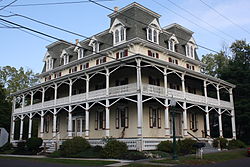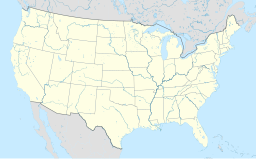Ivyland, Pennsylvania
| Borough of Ivyland | ||
| Borough | ||
|
||
| Country | United States | |
|---|---|---|
| State | Pennsylvania | |
| County | Bucks | |
| Elevation | 299 ft (91.1 m) | |
| Coordinates | 40°12′32″N 75°04′19″W / 40.20889°N 75.07194°WCoordinates: 40°12′32″N 75°04′19″W / 40.20889°N 75.07194°W | |
| Area | 0.3 sq mi (0.8 km2) | |
| - land | 0.3 sq mi (1 km2) | |
| - water | 0.0 sq mi (0 km2), 0% | |
| Population | 1,041 (2010) | |
| Density | 1,600.3/sq mi (617.9/km2) | |
| Mayor | Tony Judice | |
| Timezone | EST (UTC-5) | |
| - summer (DST) | EDT (UTC-4) | |
| ZIP Code | 18974 | |
| Area code | 215 and 267 | |
|
Location of Ivyland in Bucks County
|
||
|
Website: www |
||
Ivyland is a borough in Bucks County, Pennsylvania, United States. It is known as one of the finest collections of Victorian Buildings in the state and most of it is on the National Register of Historic Places. The population was 1,041 at the 2010 census, a 111.6% increase from the 2000 census.
Ivyland is located at 40°12′32″N 75°4′19″W / 40.20889°N 75.07194°W (40.208908, -75.071946).
According to the United States Census Bureau, the borough has a total area of 0.3 square miles (0.78 km2), all land, making it the smallest borough in Bucks County.
Ivyland was founded in 1873 by Edwin Lacey, a Quaker who was related to John Lacey, a brigadier general in the American Revolution. Edwin Lacey purchased 40 acres (16 ha) of land between Jacksonville Rd. (today's PA 332) and the Reading Company's future New Hope rail line, today's New Hope and Ivyland Railroad, which was completed to New Hope in 1891. It, as well as a large hotel which was planned for the town, was intended to serve the centennial of the signing of the Declaration of Independence.
According to the borough's website, Edwin Lacey, who apparently was no botanist, named the town for the vast amount of "ivy" growing in the area, which turned out to be poison ivy.
...
Wikipedia





